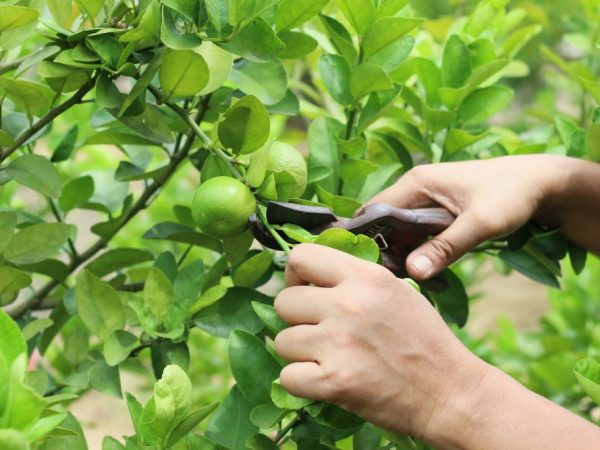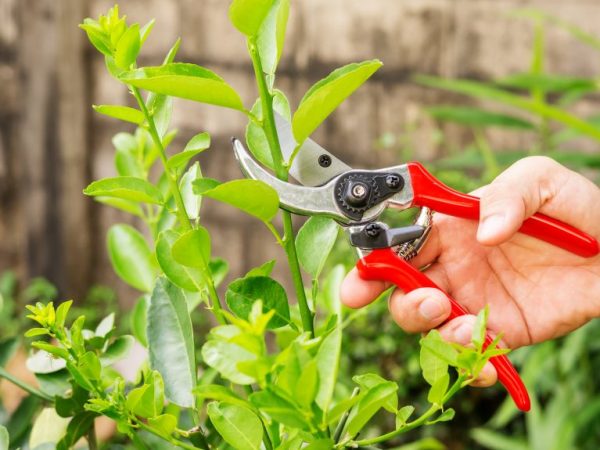Pruning lemon correctly at home
Pruning lemon at home is necessary not only to give the houseplant a neat look, but also to ensure it blooms and fructifies.

Pruning lemon correctly at home
The purpose of pruning and principles of carrying out
Lemon tree pruning is done for the following reasons:
- to give the crown a decorative look,
- to rejuvenate and extend the life cycle of an adult plant,
- to reduce the risk of fungal and bacterial diseases,
- to ensure fruiting and prolong its duration.
Principles of conducting
Lemon is cut at home, following a number of rules:
- Pruning is carried out at the dormant stage, which occurs in late autumn-early spring, until the appearance of young shoots.
- To improve the quality of fruiting for the next year, pruning is planned at the end of autumn.
- Before pruning an adult lemon tree, fruit is removed from it at the fruiting stage. A good time to prune mature citrus for aesthetic purposes is spring, from April to May.
- Lateral shoots at the first level are cut to a length of up to 25 cm, at the second level - no more than 10 cm, all subsequent ones - up to 5 cm.
An incorrectly performed procedure will give an improper direction for the development of citrus with a violation of the processes of flowering and fruiting.
Main steps
The procedure for pruning lemon at home for beginner growers is conventionally divided into 2 stages.
Initial stage
For the first time, a lemon tree is pruned in the first or second year of life. This is done so that indoor citrus does not stretch out and bear fruit. The right time is February.
Subsequent stage
The second and subsequent pruning of homemade lemon involves crown formation and includes:
- partial pruning of overly actively developing branches that take up most of the food,
- complete removal of dead and old branches that provoke the appearance of diseases,
- pruning shoots that prevent each other from developing due to their dense arrangement, leaving the strongest shoot.

At the crown, the growing process is cut off
Strong shoots growing vertically are removed, leaving less strong ones, but developing in a horizontal direction, which will ensure proportional crown growth both in breadth and in length. On the lemon crown, the growing shoot is cut off.
Scheme
How to properly prune a lemon at home:
- In the first year of the plant's life cycle, the central trunk is cut off at a height of up to 20-30 cm from the soil surface in a pot, leaving 3-4 developed buds, from where young shoots are formed and lateral branches develop further.
The kidneys should be at the same level on different sides of the central trunk.
- In the second year, vertically developing branches are additionally removed, shortening them by 25 cm. At the same time, they observe the growth of 3-4 new shoots.If only one shoot receives development, they resort to the breaking procedure: it is completely removed in order to ensure the formation of other young shoots.
- In the third year of the life of an indoor lemon, the tier of the third order is cut off.
- In the fourth year, the formation of the crown is completed by cutting off the branches of the fifth order. After completing this stage, the citrus begins to bear fruit.
Pruning problems and solutions
In some cases, difficulties arise:
- In place of the cut branches, the so-called tops develop - vertically growing branches that are not capable of fruiting. Compared to fruitful ones, they are distinguished by an increased growth rate and take away a significant proportion of nutrients in the process of caring for citrus, preventing the rest of the shoots from developing. To correct this situation, they are removed completely or cut off by 25 cm.
- Even with all the rules for pruning, homemade citrus does not bear fruit in some cases, therefore it is worth taking a closer look at the working shoots, from which the tops are pinched, which gives an impetus to the formation of fruits. Pinching is carried out when there are 6-7 leaves on the branches.
- Lemon trees over 15 years of age often stop bearing fruit regardless of good care. Spring pruning of the crown allows you to increase fruiting, in which all branches are cut up to 4-5 orders of magnitude, the plant is transplanted into a new pot, having previously shortened the roots by 30%. This stimulates the activity of dormant buds and gives an impetus to the formation of new shoots.
Conclusion
Correctly pruning indoor lemon at home allows you to give the indoor tree an aesthetic appearance and ensure full development, timely flowering and long-term fruiting. The term for the formation of the crown of a young citrus is about 3-4 years.


